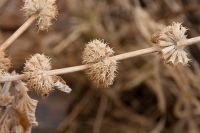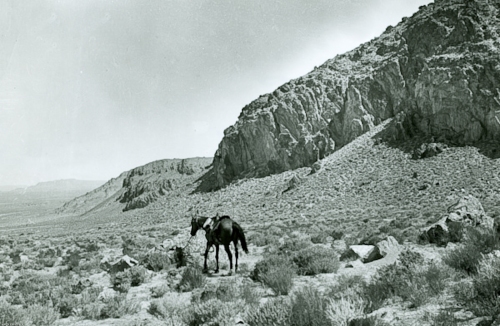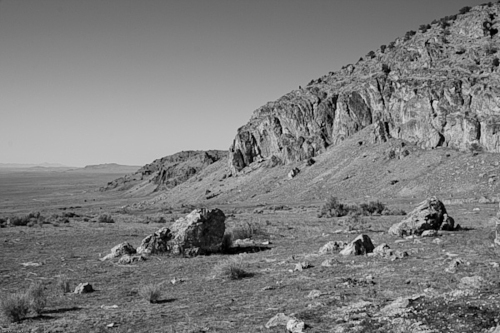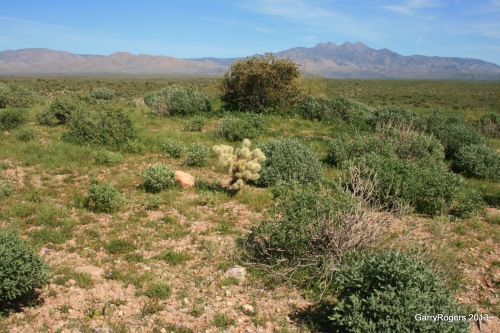By Garry Rogers
Introduction to Invasive Plants in Deserts
Invasive species, like storm troopers leading the surging ruin of global warming, are demolishing Earth’s ecosystems.

Horehound (Marrubium vulgare) seeds. This Asian invader is common in the arid uplands of central Arizona.
One or a few species of invasive plants can replace native plant communities across entire landscapes. Biodiversity and stability of vegetation, soils, and wildlife decline dramatically. Once the replacement is complete, it is difficult to restore the original species. In some instances, the replacement is so widespread there are not enough resources available to achieve restoration. The loss is permanent.
Invasive non-native species are a central management concern for all wild land managers because they “threaten biodiversity and other ecological functions and values” (Warner et al. 2003). This statement represents a consensus by the scientists and land managers concerned with natural ecosystems (e.g., Mau-Crimmins et al. 2005). Native vegetation is more diverse, resilient, and persistent than invasive plant vegetation; it provides food and cover for wildlife, absorbs precipitation, increases water storage, protects soil, reduces flooding and sedimentation, and helps maintain air and water quality. According to the Sonoran Institute: “Invasive species are the second most significant threat to biological diversity after direct habitat loss”.
Origin of Invasive Plants
Once they began crossing the oceans, Humans introduced thousands of plant species to new regions. Freed of the diseases and competitors of their homeland, some of the introduced species began spreading into native habitats. For instance, Cheatgrass (Bromus tectorum), introduced to the interior of the western U. S. during the 1800s began spreading, and now dominates many millions of acres. In 2007, the U. S. Bureau of Land Management (BLM) the principal agency responsible for managing desert land use had this to say about the state of the invasion of the western U. S. “There has also been a fourfold increase in invasive weed populations since 1985. Wildfires, drought, and invasive weeds are causing a steady degradation of soils, water quality and quantity, native plant communities, wildlife habitat, wilderness values, recreational opportunities, and livestock forage” (BLM 2007: 30).
Throughout the 20th Century, land managers across the western U. S. introduced species preferred by livestock, and eradicate unpalatable species whether native or not. Some of the introduced species invaded native habitats and displaced native species. Despite the long history of the invasion, land-use managers tend to overlook its destructive effects. They often express the view the natural landscape is of value only for production of usable plants. They speak of sustainable harvest by livestock, but so far, they have been content to take short-term views that do not stop the downward spiral of diversity and productivity.
For example, a popular range-management textbook praised Crested Wheatgass (Agropyron cristatum), a Eurasian native, for its success on western ranges. “Probably no other example exists on the dry western ranges of an introduced species that has met with unqualified success and that can be wholeheartedly recommended for increasing forage yield” (Stoddart and Smith 1943: 363). It is now well known that Crested Wheatgrass can crowd out native species and form low-diversity monocultures (Marlette and Anderson 1986, Henderson and Naeth 2005, BLM 2007), and can reduce soil fertility (Christian and Wilson 1999). Nevertheless, some public lands managers are still planting it (Davis et al. 2013).
Land Use Policies Spread Invasive Plants
Land use policies can help invasive species spread. Principal factors are:
• Livestock Grazing
• Roads, Transmission Corridors
• Outdoor Recreation
• Damage to Soil Microorganisms
• Fire: Fire prevention and control are essential for invasive plant control. A brief discussion below summarizes the linked post.
Fire and Invasive Plants
Early in the 20th Century, vegetation ecologists studying desert plant communities noticed that some alien (nonnative) weeds encouraged fire spread by making a much more continuous fuel layer than native plants made (Kearney et al. 1914). The aliens completed their life cycles and dried out by early summer. Through the summer and fall, lightening and human-caused fires became larger and more frequent than they had before the alien weeds arrived. Native plants reproduced too slowly to recover between fires. Subsequent researchers also reported the danger posed by the fire-prone invasive weeds (Leopold 1949, Hull 1965, Young et al. 1971, Rogers 1982, Rogers and Steele 1980, McLaughlin and Bowers 1982, Rogers 1986, Alford 2001, Rice et al. 2008). They recommended management strategies for finding and eradicating the weeds, but land managers ignored the warnings.
Across the western U. S., the replacement of native vegetation by invasive plants “has been so complete that only a sketchy picture of predisturbance conditions remains” (Radosevich et al. 2007: 26, and see Mack 1989, Billings 1990, Turner et al. 2010,). More than 100,000,000 acres of the native plant communities of the Great Basin are gone, replaced by Asian invasive plants (Burcham 1970, Heady 1977, Mack 1981, Babbitt 1998 Reid et al. 2008).

1901 (Gilbert). Native shrubland in the Great Basin Desert.

2008 (Rogers). Shrubland replaced by fire-prone invasive weeds.
The loss of the lower-valley and foothill shrublands and sagebrush steppe of the Great Basin and Colorado Plateau is a catastrophe for biodiversity and productivity. A similar loss of native vegetation is occurring across low-lying warmer Sonoran and Chihuahauan Deserts (Turner et al. 2010).

Fire-prone invasive plants fueled fires that converted this formerly diverse Sonoran Desert landscape of small trees and tall Saguaro cactus into an impoverished shrubland.
Failed Land Management
The lost diversity and productivity of millions of acres of native rangeland makes it clear that the policies of the BLM, U. S. Forest Service, state land agencies, and others are inadequate to protect the land. Current management policies and practices include options to make necessary land use changes to stop the spreading deterioration resulting from the use of exotic species. But since all the land use agencies insist on continuing livestock grazing, mining, energy development, and recreation, their efforts continue to fail.
Invasive Plants Conclusion
According to the BLM Arizona Standards for Rangeland Health (BLM 1997), the unifying goal for many rangeland health conditions is “significant progress.” Despite many positive BLM annual reports of significant progress, the facts show that there has been significant deterioration due to the dramatic increase in invasive weeds.
The fire-weed cycle is sweeping away native vegetation and wildlife of North American deserts. None of the destructive land-management practices of the BLM and other public agencies has changed. Livestock continue to destroy soil microorganisms and make room for invasive plants. Roads and recreation continue to do the same. Managers use herbicides without testing their effects; they use controlled burning to remove woody species in the hope of encouraging growth of grasses and herbs that livestock will eat; they make no effort to protect soil microorganisms.
Restoring and protecting native vegetation can cost more than $100,000 per acre. Replacing the Cheatgrass in the Great Basin with native vegetation would cost as much as bailing out 10 large banks or supporting the U. S. military for 8 years. Since corporations and politicians would have to face the uncertainties of developing new income streams, the replacement will not occur.
Invasive Plants Recommendations
- Remove livestock and block recreation until soil microorganisms recover.
- Stop construction of new roads, transmission corridors, and trails.
- Stop introducing alien species and using fire and herbicides without knowing the consequences.
- Appeal for more funding and public support for invasive plant removal and native plant reestablishment.
- Call for careful appraisal of research knowledge and gaps
- Use testing and adaptive management to improve management techniques.
- Give weed prevention and monitoring the priority effort they deserve (weed management strategies and tactics are covered in the references and in a post in preparation).
Invasive Plants References
- Alford, E. J. 2001. The effects of fire on Sonoran Desert plant communities. Dissertation, Arizona State University, Tempe, AZ. 109 p.
- Babbitt B. 1998. Statement by Secretary of the Interior on invasive alien species. “Science in wildland weed management.” Symposium, April 8-10, 1998. Denver, CO. U. S. Department of the Interior.
- Billings, W. D. 1990. Bromus tectorum, a biotic cause of ecosystem impoverishment in the Great Basin. Pages 301-322 in G. M. Woodell, ed. The earth in transition: Patterns and processes of biotic impoverishment. Cambridge University Press, Cambridge, England.
- BLM. 1997. Arizona standards for rangeland health and guidelines for grazing administration. USDI, Bureau of Land Management Arizona. 18 p.
- BLM. 2007. The Bureau of Land Management’s Performance and Accountability Report for Fiscal Year 2007. Online: http://www.blm.gov/public.
- Burcham, L. T. 1970. Ecological significance of alien plants in California grassland. Proceedings of the Association of American Geographers 2:36-9.
- Christian, J. M., and S. D. Wilson. 1999. Long-term ecosystem impact of an introduced grass in the Northern Great Plains. Ecology 80:2397-2407.
- Davis, K. W., C. S. Boyd, and A. M. Nafus. 2013. Restoring the Sagebrush Component in Crested Wheatgrass-Dominated Communities. Rangeland Ecology and Management 66:472-478.
- Heady, H. F. 1977. Valley grassland. Pages 491-514 in M. G. Barbour and J. Major. Terrestrial vegetation of California. John Wiley and Sons, New York. 1002 p.
- Henderson, D.C., and M.A. Naeth. 2005. Multi-scale impacts of crested wheatgrass invasion in mixed-grass prairie. Biological Invasions 7:639-650.
- Hull, A. C., Jr. 1965. Cheatgrass—a persistent homesteader. Pages 21-26 in Bureau of Land Management. Proceedings cheatgrass symposium. Bureau of Land Management, Oregon-Washington State Office. 92 p.
- Kearney, T. H., L. J. Briggs, and H. T. Shantz. 1914. Indicator significance of vegetation in Tooele Valley, Utah. Agricultural Research 1:365-417.
- Leopold, A. 1949. A Sand County almanac and sketches here and there. Oxford University Press, New York. 226 p.
- Mack, R. N. 1981. Invasion of Bromus tectorum L. into western North America: An ecological chronicle. Agro-Ecosystems 7:145-165.
- Mack, R. N. 1989. Temperate grasslands vulnerable to plant invasions: Characteristics and consequences. Pages 155-179 in Drake et al., eds. SCOPE 37, biological invasions, a global perspective. John Wiley & Sons, New York, NY. 506 p.
- Marlette, G.M., and J.E. Anderson. 1986. Seed banks and propagule dispersal in crested-wheatgrass stands. Journal of Applied Ecology 23:161-175.
- Mau-Crimmins, T., A. Hubbard, D. Angell, C. Filippone, N. Kline. 2005. Sonoran Desert Network Vital Signs Monitoring Plan. Technical Report NPS/IMR/SODN-003. National Park Service. Denver, CO.
- McLaughlin, S., and J. Bowers. 1982. Effects of wildfire on a Sonoran Desert plant community. Ecology 63:246-248.
- Pellant, M., P. Shaver, D.A. Pyke, and J.E. Herrick. 2005. Interpreting indicators of rangeland health, version 4. Technical Reference 1734-6. U.S. Department of the Interior, Bureau of Land Management, National Science and Technology Center, Denver, CO. BLM/WO/ST-00/001+1734/REV05. 122 p.
- Printz, J.L., D. Toledo, and S.C. Boltz. 2014. Rangeland health assessment: The key to understanding and assessing rangeland soil health in the Northern Great Plains. Journal of Soil and Water Conservation 69: 73a-77a.
- Radosevich, S. R., J. S. Holt, and C. Ghersa. 2007. Weed ecology: implications for management. John Wiley and Sons, New York, NY. 589 p.
- Rice, P. M., G. R. McPherson, and L. J. Rew. 2008. Fire and nonnative invasive plants in the interior west bioregion. Pages 140-174 in Zouhar, K., J. K. Smith, S. Sutherland, and M. L. Brooks. 2008. Wildland fire in ecosystems: Fire and nonnative invasive plants. U. S. Forest Service, Rocky Mountain Research Station, General Technical Report RMRS-GTR-42-Vol. 6. Ogden, UT. 355 p.
- Rogers, G. 1982. Then and Now: A Photographic History of Vegetation Change in the Central Great Basin Desert. Univer¬sity of Utah Press, Salt Lake City, UT. 188 p.
- Rogers, G. 1985. Mortality of burned Cereus giganteus. Ecology 66:630 632.
- Rogers, G. 1986. Comparison of fire occurrence in desert and nondesert vegetation in Tonto National Forest, Arizona. Madroño 33:278-283.
- Rogers, G. and J. Steele. 1980. Sonoran desert fire ecology: Adaptive strategies of perennial plant species. U.S. Forest Service, General Technical Report RM 81:15 19.
- Stoddart, L. A., and A. D. Smith. 1943. Range management. McGraw-Hill, New York, NY. 547 p.
- Tellman, B. ed. 2002. Invasive exotic species in the Sonoran Desert region. University of Arizona Press and Arizona-Sonora Desert Museum, Tucson, AZ. 420 p.
- Turner, R.M., R. H. Webb, T. C. Esque, and G. F. Rogers. 2010. Repeat photography and low elevation fire responses in the southwestern United States. Pages 223-244 in R. H. Webb, D. E. Boyer, and R. M. Turner, eds. Repeat photography methods and applications in the natural sciences. Island Press, Washington DC. 337 p.
- Warner, P. J., C. C. Bossard, M. L. Brooks, J. M. DiTomaso, J. A. Hall, A. M. Howald, D. W. Johnson, J. M. Randall, C. L. Roye, M. M. Ryan, and A. E. Stanton. 2003. Criteria for categorizing invasive non-native plants that threaten wildlands. Online: http://www.caleppc.org and http://www.swvma.org. California Exotic Pest Plant Council and SW Vegetation Management Association. 24 pp.
- Young, J. A., R. A. Evans, and J. Major. 1971. Alien plants in the Great Basin. Journal of Range Management 25:194-201.
